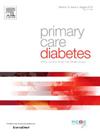Prevalence of prediabetes according to sleep apnea status
IF 2.6
4区 医学
Q3 ENDOCRINOLOGY & METABOLISM
引用次数: 0
Abstract
Aim
The association between obstructive sleep apnea (OSA) and prediabetes using the STOP-Bang questionnaire remains unknown. We aimed to investigate the prevalence of prediabetes among people based on their sleep apnea status.
Methods
This cross-sectional study included 10131 Korean adults without diabetes with information of STOP-Bang scores, drawn from the dataset of the Korea National Health and Nutrition Examination Survey 2019–2021. Prediabetes was defined in three subsets: only by fasting blood glucose (FBG) (FBG 100–125 mg/dL, HbA1c <5.7 %), only by HbA1c (FBG <100 mg/dL, HbA1c 5.7–6.4 %) or by both. We used multivariable logistic regression to assess the odds ratio (OR) and 95 % confidence intervals (CIs) for prediabetes.
Results
A total of 3828 subjects reported a STOP-Bang score of ≥ 3, which shows increased risk of OSA. Multivariable-adjusted OR (95 % CI) showed that a STOP-Bang score ≥ 3 was associated with prediabetes meeting both FBG and HbA1c criteria (OR 1.06; 95 % CI 1.01–1.12). This association was statistically significant among women, particularly postmenopausal women (OR 1.20, 95 % CI 1.10–1.30; OR 1.21, 95 % CI 1.11–1.32, respectively).
Conclusion
In Korean general population, a significant correlation between higher OSA risk and prediabetes was observed, especially in postmenopausal women.
与睡眠呼吸暂停状态相关的前驱糖尿病患病率。
目的:使用STOP-Bang问卷调查阻塞性睡眠呼吸暂停(OSA)和前驱糖尿病之间的关系尚不清楚。我们的目的是根据人们的睡眠呼吸暂停状态来调查前驱糖尿病的患病率。方法:本横断面研究纳入10131名无糖尿病的韩国成年人,并提供STOP-Bang评分信息,数据来自2019-2021年韩国国家健康与营养检查调查数据集。糖尿病前期分为三个亚群:仅通过空腹血糖(FBG) (FBG 100-125 mg/dL, HbA1c)来定义。结果:共有3828名受试者报告STOP-Bang评分≥ 3,表明OSA的风险增加。多变量校正OR(95 % CI)显示STOP-Bang评分≥ 3与糖尿病前期同时满足FBG和HbA1c标准相关(OR 1.06;95 % ci 1.01-1.12)。这种关联在女性中具有统计学意义,尤其是绝经后女性(OR 1.20, 95 % CI 1.10-1.30;OR 1.21, 95 % CI分别为1.11-1.32)。结论:在韩国普通人群中,观察到OSA高风险与前驱糖尿病之间存在显著相关性,尤其是绝经后妇女。
本文章由计算机程序翻译,如有差异,请以英文原文为准。
求助全文
约1分钟内获得全文
求助全文
来源期刊

Primary Care Diabetes
ENDOCRINOLOGY & METABOLISM-PRIMARY HEALTH CARE
CiteScore
5.00
自引率
3.40%
发文量
134
审稿时长
47 days
期刊介绍:
The journal publishes original research articles and high quality reviews in the fields of clinical care, diabetes education, nutrition, health services, psychosocial research and epidemiology and other areas as far as is relevant for diabetology in a primary-care setting. The purpose of the journal is to encourage interdisciplinary research and discussion between all those who are involved in primary diabetes care on an international level. The Journal also publishes news and articles concerning the policies and activities of Primary Care Diabetes Europe and reflects the society''s aim of improving the care for people with diabetes mellitus within the primary-care setting.
 求助内容:
求助内容: 应助结果提醒方式:
应助结果提醒方式:


